|

|
|
| |
|
China Oil Painting Direct
|
|
100% hand painted, 100%
cotton canvas,
100% money back if not satisfaction.
|
|
|
|
ART WORKS
INDEX
A B C D E F G H I J K L M N O P Q R S T U V W X Y Z
|
|
ARTISTS
INDEX
A B C D E F G H I J K L M N O P Q R S T U V W X Y Z
|
|
|
|
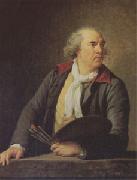 |
Elisabeth Louise Viegg-Le Brun 
|
|
Paris 1755-1842
|
|
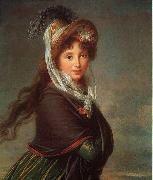 |
Elisabeth LouiseVigee Lebrun 
|
|
(1755-1842)
French Elisabeth Louise Vigee Lebrun Galleries
|
|
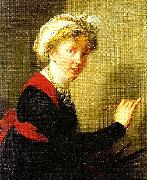 |
elisabeth vigee-lebrun 
|
|
Élisabeth-Louise Vigee-Le Brun, född 16 april 1755 i Paris, död 30 mars 1842 i Louveciennes, 20 kilometer väster om Paris, var en fransk målare som i huvudsak målade porträtt.
Vigee-Lebrun utförde tilldragande, idealiserande porträtt och var för en tid hovmålare hos drottning Marie Antoinette. Vigee-Lebrun var tvungen att lämna Frankrike pågrund av den franska revolutionen 1789 och efter det var hon verksam i Ryssland, Italien och Storbritannien. Efter att Napoleons kommit till makten återvände hon till Frankrike. Hon besökte Schweiz 1807 där hon i Geneve blev invald som hedersmedlem i Societe pour l'Avancement des Beaux-Arts.
Vigee-Le Brun lämnade ett arv av 660 porträttmålningar och 200 landskapsmålningar. Dessa finns i privata samlingar i Europa och USA men även i stora museer som Eremitaget, National Gallery i London, Metropolitan Museum of Art i New York och National Gallery of Art i Washington, D.C..
|
|
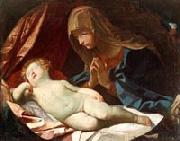 |
Elisabetta Sirani 
|
|
(8 January 1638 -25 August 1665) was an Italian Baroque painter whose father was the painter Giovanni Andrea Sirani of the School of Bologna
She was born in Bologna. By age 17 she was a full-fledged engraver and painter and had completed over ninety works. By the time she died at the young age of 27, she had added at least eighty more to her repertoire. Besides being an independent painter by the age of 19, Elisabetta Sirani also ran her family's workshop. When her father became incapacitated by gout, she was burdened with having to support her parents, her siblings and herself, entirely through her art. The stress created by such heavy responsibilities may have been the cause of her early death. It is estimated that in all she produced some 200 paintings, drawings, and etchings. She painted themes such as the Virgin and Child, self portraits, and many more.
Elisabetta Sirani used dramatic light and great movement in her work, which classified it in the Baroque style. She painted many of her larger scale and heavy-themed works publicly and in front of large (and adoring) crowds of on-lookers. Sirani's portraits, mythological subjects, and especially her images of the Holy Family and the Virgin and Child, gained international fame.
|
|
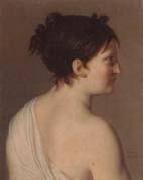 |
Elise Bruyere 
|
|
French ,
Paris 1776-1842
|
|
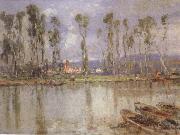 |
Eliseo Meifren y Roig 
|
|
Spanish, 1859-1940
|
|
 |
Eliseu Visconti 
|
|
1867-1944
Eliseu Visconti Gallery
Brazilian painter and decorative artist, of Italian birth. He was taken as an infant from Italy to Rio de Janeiro. In 1884 he began studying in Rio de Janeiro at the Academia Imperial das Belas Artes and the Liceu Imperial de Artes e Of?cios under Victor Meirelles de Lima, Henrique Bernardelli (1837-1946) and Rodolfo Amoedo (1857-1941). He was active in efforts to eliminate the academy's rigid academic discipline. He went to Paris in 1892 and attended the Ecole des Beaux-Arts and the Ecole des Arts D?coratifs, where he was taught by Eug?ne-Samuel Grasset. At the 1900 Exposition Universelle in Paris, Visconti won a silver medal for the paintings Youth (1898) and Dance of the Wood Nymphs (1899; both Rio de Janeiro, Mus. N. B.A.). Following the Pre-Raphaelites, his main influences were Botticelli and other painters of the Italian Renaissance, but he was also affected by Grasset and Art Nouveau. On his return to Brazil, among the works exhibited in 1901 in Rio de Janeiro were a series of ceramic objects with Brazilian floral motifs and designs for postage stamps. His florid style began to give way to Impressionism in the stage curtain, circular ceiling panel and proscenium frieze he executed for the Rio de Janeiro Teatro Municipal (1906-7; in situ). In 1906 he became director of painting at the Escola Nacional de Belas Artes in Rio de Janeiro.
|
|
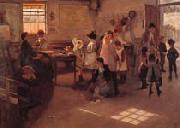 |
Elizabeth Armstrong 
|
|
Canadian-born English Painter, 1859-1912
|
|
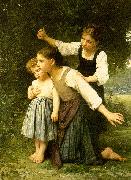 |
Elizabeth Gardner Bouguereau 
|
|
1837-1922
|
|
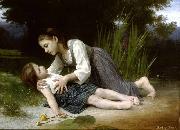 |
Elizabeth Jane Gardner 
|
|
(October 4, 1837-January 28, 1922) was an American academic and salon painter, who was born in Exeter, New Hampshire. She was an American expatriate who died in Paris where she had lived most of her life. She studied in Paris under the figurative painter Hugues Merle (1823-1881), the well-known salon painter Jules Joseph Lefebvre (1836-1911), and finally under William-Adolphe Bouguereau (1825-1905). After Bouguereau's wife died, Gardner became his paramour and after the death of his mother, who bitterly opposed the union, she married him in 1896. She adopted his subjects, compositions and even his smooth facture, adopted them so successfully that some of her work might be mistaken for his. Gardner's best known work may be The Shepherd David Triumphant (1895), which shows the young shepherd with the lamb he has rescued. Among her other works were "Cinderella," "Cornelia and Her Jewels," "Corinne," "Fortune Teller," "Maud Muller," "Daphne and Chloe," "Ruth and Naomi," "The Farmer's Daughter," "The Breton Wedding," and some portraits.
|
|
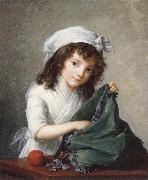 |
Elizabeth Louise Vigee Le Brun 
|
|
French Neoclassical Painter, 1755-1842
|
|
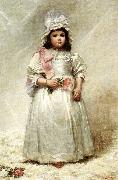 |
Elizabeth Lyman Boott Duveneck 
|
|
1846-1888
Elizabeth Lyman Boott Duveneck Gallery
|
|
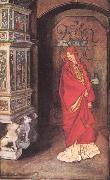 |
Elizabeth Shippen Green 
|
|
American Golden Age Illustrator, 1871-1954
was an American illustrator. She illustrated children's books and worked for many years for Harper's Magazine. Green studied with the painters Thomas Anshutz and Robert Vonnoh at the Pennsylvania Academy of Fine Arts (1889-1893). She then began study with Howard Pyle at Drexel Institute where she met Violet Oakley and Jessie Willcox Smith. Life was made for love and cheer; Watercolor and charcoal on board, Harper's Magazine, September 1904She had already begun publishing when she was eighteen and began making pen and ink drawings and illustrations for St. Nicholas Magazine, Woman's Home Companion, and the Saturday Evening Post. In 1911, she signed an exclusive contract with Harper's Monthly. Green was also a prolific book illustrator. Green became close and lifelong friends with Oakley and Smith. They lived together first at the Red Rose Inn (they were called the Red Rose girls by Pyle) and later at Cogslea, their home in the Mount Airy neighborhood of Philadelphia. In 1911, Green married Huger Elliott, an architecture professor.
|
|
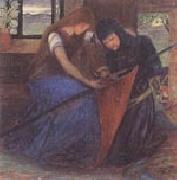 |
Elizabeth Siddal 
|
|
British Pre-Raphaelite Artist , 1829-1862
was a British artists' model, poet and artist who was painted and drawn extensively by artists of the Pre-Raphaelite Brotherhood. Siddal was perhaps the most important model to sit for the Pre-Raphaelite Brotherhood. Their ideas about feminine beauty were profoundly influenced by her, or rather she personified those ideals. She was Dante Gabriel Rossetti's model par excellence; almost all of his early paintings of women are portraits of her. She was also painted by Walter Deverell, William Holman Hunt and John Everett Millais, and was the model for Millais' well known Ophelia (1852). Named Elizabeth Eleanor Siddall, after her mother, Lizzie was born on 25 July, 1829, at the family??s home at 7 Charles Street, Hatton Garden. She was born to Charles Siddall and Eleanor Evans, a family of English and Welsh descent. At the time of Lizzie??s birth, her parents were not poverty stricken. Her father had his own cutlery-making business. Around 1831, the Siddall family moved to the borough of Southwark, in south London, a less salubrious area than Hatton Garden. It was in Southwark that the rest of Lizzie??s siblings were born: Lydia, to whom Lizzie was particularly close, Mary, Clara, James and Henry. Although there is no record of her having attended school, Lizzie was able to read and write, presumably having been taught by her parents. She developed a love of poetry at a young age, after discovering a poem by Tennyson on a scrap of newspaper that had been used to wrap a pat of butter. This discovery was one of Lizzie??s inspirations to start writing her own poetry. Model for the Pre-Raphaelites Siddal, whose name was originally spelt 'Siddall' (it was Rossetti who dropped the second 'l') was first noticed by Deverell in 1849, while she was working as a milliner in Cranbourne Alley, London. She was the daughter of Charles Crooke Siddall, a cutler who claimed that his family descended from nobility, and his wife Elizabeth Eleanor Evans Siddall. Neither she nor her family had any artistic aspirations or interests. She was employed as a model by Deverell and through him was introduced to the Pre-Raphaelites. The twenty-year-old with her tall thin frame and copper hair was the first of the Pre-Raphaelite stunners. William Michael Rossetti, her brother-in-law, described her as "a most beautiful creature with an air between dignity and sweetness with something that exceeded modest self-respect and partook of disdainful reserve; tall, finely-formed with a lofty neck and regular yet somewhat uncommon features, greenish-blue unsparkling eyes, large perfect eyelids, brilliant complexion and a lavish heavy wealth of coppery golden hair.
|
|
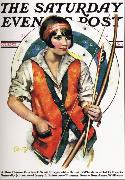 |
Ellen Bernard Thompson 
|
|
American , 1876-1936
|
|
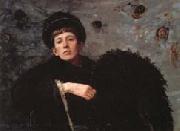 |
Ellen Day Hale 
|
|
1855-1940
was an American painter and printmaker. She was born in Worcester, Massachusetts, her family was involved in the arts, her father Edward Everett Hale was an author, her great-aunt Harriet Beecher Stowe wrote Uncle Tom's Cabin. She studied art under Boston painter William Morris Hunt and helped raise her 7 brothers and sisters. Later she studied in at the Academie Julien in Paris.
|
|
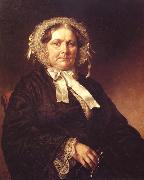 |
Elliott Charles Loring 
|
|
born in Scipio, New York, in December 1812; died in Albany, NY., 25 Sept., 1868.
died in Albany, NY., 25 Sept., 1868., American painter. Resolved to become an artist, he moved from Syracuse, NY, to New York City around 1830, bearing a letter of introduction to John Trumbull and reportedly receiving some brief instruction from him. Elliott spent six months in the studio of the genre painter John Quidor but returned to upstate New York, where he worked for several years as an itinerant portrait painter. Back in New York City by 1839, his art steadily improved; Henry Inman met him around 1844-5, whereupon he predicted: 'When I am gone that young man will take my place'. Elliott's portrait of Capt. John Ericsson (c. 1845; untraced) won praise in 1845 as 'the best American portrait since [Gilbert] Stuart', and from that date he was acknowledged as New York's leading portrait painter. His facility for capturing a vivid, characteristic likeness and his genial personality assured a constant stream of private patrons and public commissions. In 1867 it was reported that he had executed nearly 700 portraits.
|
|
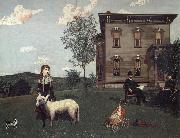 |
Elmer Edwin Romanzo 
|
|
Portrait, genre and still life painter
b.1850 d.1923
was an American portrait, genre and still life painter. Known for his attention to detail, he was also an inventor of a machine for braiding horsewhips. Spending most of his life in Ashfield, Massachusetts, Elmer is best known for his painting Mourning Picture. This 1890 family portrait depicts the artist, his wife, and their daughter Effie who had died shortly before it was painted. The painting is noted for its intricate detail and the contrast between the mourning family, who sits in relative darkness, and the dead daughter, who is bathed in sunlight. It was first displayed in a local post office in 1890, then disappeared until the 1950's.
|
|
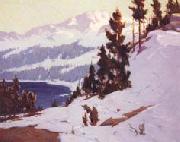 |
Elmer Wachtel 
|
|
American Painter, 1864-1929
|
|
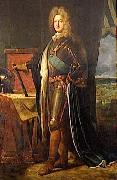 |
Eloi Firmin Feron 
|
|
painted Eloi Firmin Feron in 1834
|
|
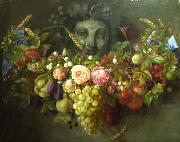 |
Eloise Harriet Stannard 
|
|
painted Garland of Fruits and Flowers, painted by Eloise Harriet Stannard in 1865
|
|
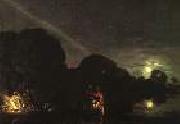 |
ELSHEIMER, Adam 
|
|
German Baroque Era Painter, 1578-1610
German painter, printmaker and draughtsman, active in Italy. His small paintings on copper established him after his brief life as the most singular and influential German artist to follow D?rer. Their grand conception in terms of monumental figures and poetic landscape and their meticulous, miniature-like execution were admired by Rubens and came to influence many 17th-century artists, including Rembrandt. Most were produced in Rome after 1600:
|
|
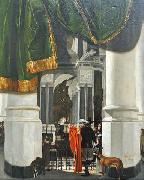 |
Emanuel de Witte 
|
|
(1617 - 1692) was a Dutch perspective painter. In contrast to Pieter Jansz Saenredam, who emphasized architectural accuracy, De Witte was more concerned with the atmosphere of his interiors. Though few in number, de Witte also produced genre paintings.
De Witte was born in Alkmaar and learned geometry from his father, a schoolmaster. He joined the local Guild of St Luke in 1636. After a stay in Rotterdam, he moved to Delft and studied with Evert van Aelst. In 1651 de Witte settled in Amsterdam where his first wife, Geerje Arents, died in 1655. He then married a 23-year-old orphan, Lysbeth van der Plas, who exercised a bad influence on de Witte's adolescent daughter. In December 1659 both were arrested for theft from a neighbor.Lysbeth, pregnant, had to leave the city for a period of six years; she lived outside the city walls and died in 1663.
Following the arrest of his wife and child, de Witte was forced to indenture himself to the Amsterdam notary and art dealer Joris de Wijs, surrendering all of his work in exchange for room, board, and 800 guilders annually. De Witte broke the contract, was sued by the dealer, and forced to indenture himself further as a result. Several patrons provided de Witte with support, but these relations did not work out well, for he tended to shout at his clients and at people watching him at work in churches. Records tell of his gambling habit and a fight with Gerard de Lairesse. According to Arnold Houbraken, after an argument about the rent, de Witte hanged himself from a canal bridge in 1692. The rope broke and de Witte drowned. Because the canal froze that night, his corpse was not found until eleven weeks later
|
|
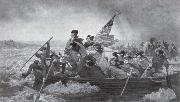 |
Emanuel Gottlieb Leutze 
|
|
German-born American Romantic Painter, 1816-1868,American painter of German birth. When he was nine, Leutze's family emigrated to America and settled in Philadelphia. In 1834 he began to study art with the draughtsman John Rubens Smith (1775-1849). Leutze developed his skills as a portrait painter by taking likenesses to be engraved for publication in the National Portrait Gallery of Distinguished Americans and then working as an itinerant painter. He also experimented with imaginative compositions, such as the Poet's Dream (Philadelphia, PA Acad. F.A.). Philadelphia patrons sponsored his study in Europe, and in 1841 he enrolled at the K?nigliche Kunstakademie in Desseldorf. Although attempts at history painting won approval in Germany and in the USA, Leutze left the academy in 1843. He travelled for two years in Germany and Italy, during which time he became convinced of the importance of freedom and democracy, which he believed to be fundamental institutions of the American political system.
|
|
 |
Emanuel Leutze 
|
|
historical painter, born in Gmund, Wurtemberg, 24 May, 1816; died in Washington, DC 18 July, 1868.American painter of German birth. When he was nine, Leutze's family emigrated to America and settled in Philadelphia. In 1834 he began to study art with the draughtsman John Rubens Smith (1775-1849). Leutze developed his skills as a portrait painter by taking likenesses to be engraved for publication in the National Portrait Gallery of Distinguished Americans and then working as an itinerant painter. He also experimented with imaginative compositions, such as the Poet's Dream (Philadelphia, PA Acad. F.A.). Philadelphia patrons sponsored his study in Europe, and in 1841 he enrolled at the Kenigliche Kunstakademie in Desseldorf. Although attempts at history painting won approval in Germany and in the USA, Leutze left the academy in 1843. He travelled for two years in Germany and Italy, during which time he became convinced of the importance of freedom and democracy,
|
|
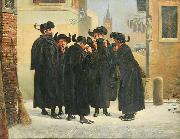 |
Emanuel Salomon Friedberg 
|
|
painted Jews Taking Snuff in 1885
|
|
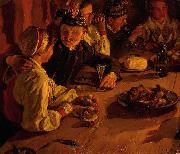 |
Emerik Stenberg 
|
|
painted Julagille i Dalarna in 1916
|
|
|
|
Emil Barentzen 
|
|
Emilius Ditlev Bærentzen, usually known as Emil Barentzen, (30 October 1799, Copenhagen - 14 February 1868, Copenhagen) was a Danish portrait painter and lithographer, active during the Golden Age of Danish Painting.
Born in Copenhagen on 30 October 1799, Barentzen served an apprenticeship at the pharmacy in Nykobing Sjælland but then travelled to Christiansted on the then Danish island of St. Croix in the West Indies where he worked in one of the government offices. Five years later he returned to Denmark and, after qualifying as a lawyer, moved into painting which until then he had practiced as a hobby. In 1821, he entered the Danish Academy where he studied under Christoffer Wilhelm Eckersberg. He was awarded the little silver medal in 1826 and the large silver medal the following year. He soon became one of Copenhagen's most popular portrait painters. His paintings were characterized by an elegant but sober style, free of psychological trimmings in accordance with contemporary practice. One of his most successful works is the portrait of Soren Kirkegaard's fiancee Regine Olsen (1840).
In 1837, he began to specialize in lithography with H.L. Danschell who managed his deceased father-in-law's oilcloth factory where stones were used to colour the fabric. This led to the founding of a lithographic company, Emilius Bärentzen & Co.s litografiske Institut, which later became Hoffensberg, Jespersen & Fr. Trap. Bærentzen made lithographs of many of the period's most important figures. He continued to work both as a lithographer and artist until 1866 when he painted the portraint of Cosmus Bræstrup for the Freemasons lodge in Helsingor. He died on 14 February 1868.
|
|
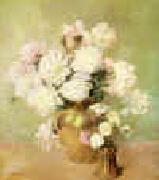 |
Emil Carlsen 
|
|
Danish-born American Painter, 1853-1932
Soren Emil Carlsen (1853 ?C 1932) was an American painter associated with the Cos Cob Art Colony.
Carlsen painted primarily landscapes and still lifes. His fastidiously painted still lifes are influenced by Chardin and often depict copper pans, game, or flowers. He was an art teacher for over fifty years; his students included James Swinnerton.
|
|
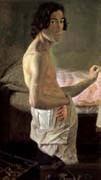 |
Emil janssen 
|
|
1807-45
|
|
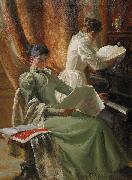 |
Emil Lindgren 
|
|
painted Interior med musicerande kvinnor vid pianot in 1893
|
|
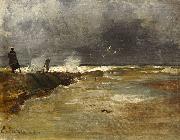 |
Emil Neumann 
|
|
painted Strandspaziergang bei Wellengang in 1890
|
|
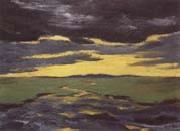 |
Emil Nolde 
|
|
German Expressionist Painter, 1867-1956.German painter, watercolourist and printmaker. He was one of the strongest and most independent of the German Expressionists. Nolde belonged to the Dresden-based group known as DIE BR?CKE from 1906 to 1907. Primarily a colourist, he is best known for his paintings in oil, his watercolours and his graphic work. His art was deeply influenced by the stark natural beauty of his north German homeland, and alongside numerous landscapes, seascapes and flower paintings, Nolde also produced works with religious and imaginary subjects.
|
|
 |
Emil Orlik 
|
|
(July 21, 1870 - September 28, 1932) was born in Prague, which was at that time part of the Austro-Hungarian Empire, and lived and worked in Prague, Austria and Germany. He was a painter, an etcher and lithographer.
In 1905 Emil Orlik moved to Berlin and took a post at the "School for Graphic and Book Art" of the Museum of Decorative Arts (Kunstgewerbemuseum), now part of the Berlin State Museums.
|
|
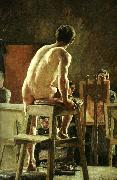 |
emil osterman 
|
|
male model and pupils. ca. 1892
royal academy of fine arts
|
|
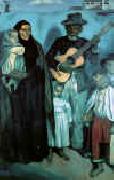 |
Emile Bernard 
|
|
1868-1941
French
Emile Bernard Galleries
(b Lille, 28 April 1868; d Paris, 15 April 1941). French painter and writer. He was the son of a cloth merchant. Relations with his parents were never harmonious, and in 1884, against his fathers wishes, he enrolled as a student at the Atelier Cormon in Paris. There he became a close friend of Louis Anquetin and Toulouse-Lautrec. In suburban views of Asnires, where his parents lived, Bernard experimented with Impressionist and then Pointillist colour theory, in direct opposition to his masters academic teaching; an argument with Fernand Cormon led to his expulsion from the studio in 1886. He made a walking tour of Normandy and Brittany that year, drawn to Gothic architecture and the simplicity of the carved Breton calvaries. In Concarneau he struck up a friendship with Claude-Emile Schuffenecker and met Gauguin briefly in Pont-Aven. During the winter Bernard met van Gogh and frequented the shop of the colour merchant Julien-Franois Tanguy, where he gained access to the little-known work of Cezanne.
|
|
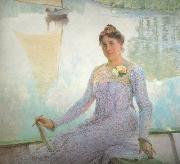 |
Emile Claus 
|
|
Belgian Painter, 1849-1924
Belgian painter. He had various menial jobs before the composer Peter Benoet persuaded his father to let him study at the Koninklijke Academie voor Schone Kunsten in Antwerp. He was taught there by Nicaise De Keyser and Jacob Jacobs (1812-79) but found the atmosphere uncongenial and soon left. In 1879 he travelled around Spain and North Africa and in 1881 went to live with his sister at Waereghem. His painting of this period was influenced by Charles Verlat and depicted rural subjects
|
|
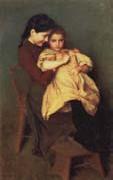 |
Emile Friant 
|
|
French Realist Painter, 1863-1932, Was a French painter. With a naturalist style Emile Friant painted quotidian scenes involving people. His creations are characterized by the photographic realism of the human skin portions, and a less defined portrayal of the rest of the scene.
|
|
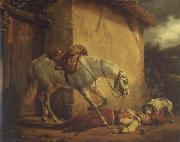 |
Emile Jean Horace Vernet 
|
|
French, 1789-1863,Painter, son of Carle Vernet. He was born in his father's lodgings at the Palais du Louvre, where his grandfather Joseph Vernet also lived; his maternal grandfather was Jean-Michel Moreau. To these antecedents and influences are ascribed the supreme ease of his public career, his almost incredible facility and his fecundity. His early training in his father's studio was supplemented by formal academic training with Francois-Andre Vincent until 1810, when he competed unsuccessfully for the Prix de Rome. He first exhibited at the Salon in 1812. In 1814 Vernet received the Legion d'honneur for the part he played in the defence of Paris, which he commemorated in the Clichy Gate: The Defence of Paris, 30 March 1814.
|
|
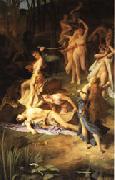 |
Emile Levy 
|
|
Paris 1826 - Paris 1890.
French Academic Painter, 1826-1890.
Studied under François-Edward Picot and Abel de Pujol.
|
|
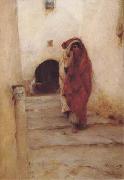 |
Emile Pinchart 
|
|
French, 1842 to 1924
|
|
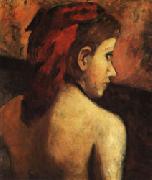 |
Emile Schuffenecker 
|
|
French Post-Impressionist Painter, 1851-1934
French painter. In 1871 he entered the stockbroking firm of Bertin, where he met Paul Gauguin who was also employed there. In his spare time he took drawing classes and studied with Paul Baudry and Carolus-Duran, making his debut at the Salon in 1874. He also became acquainted with Armand Guillaumin and Camille Pissarro. Following the stock market crash of 1882, he, like Gauguin, was forced to leave Bertin and gained a job teaching art at the Lycee Michelet in Vanves. In 1884 he was one of the co-founders of the Salon des Independants and took part in the 8th and last Impressionist Exhibition in 1886, the year in which he also met Emile Bernard in Concarneau and sent him on to see Gauguin, thus initiating their joint development of CLOISONNISM. Though he mixed with the members of the Pont-Aven group his own artistic tastes were very different. While Gauguin and his disciples had little more than contempt for Neo-Impressionism, Schuffenecker was much interested in pointillist techniques.
|
|
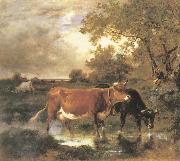 |
Emile Van Marcke de Lummen 
|
|
1827-1890
Emile van Marcke was born in S??vres - into a family of artists. His father was Jean-Baptiste (1797-1848), the eldest son of Charles van Marcke and a painter who specialized not only in landscape and animal paintings, but also works on porcelain.
|
|
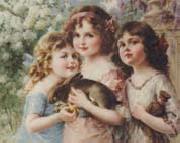 |
Emile Vernon 
|
|
British
1890-1920
|
|
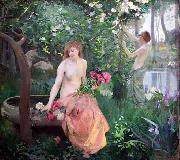 |
emile-Rene Menard 
|
|
(1861 - 1930) was a French painter born in Paris. From early childhood he was immersed in an artistic environment: Corot, Millet and the Barbizon painters frequented his family home, familiarizing him thus with both landscape and antique subjects.
Menard studied at the Academy Jullian from 1880 after having been a student of Baudry, Bouguereau, and Henri Lehmann. He participated in the Salon of the Secession in Munich, and the Salon de la Libre Esthetique in Brussels during 1897. Several personal exhibitions were also devoted to him at the Georges Small Gallery. In 1921 he exhibited in the Twelfth Salon along with Henri Martin and Edmond Aman-Jean. Galleries in Buffalo, New York and Boston, Massachusetts exposed Menard and his art to the United States. However, the numerous commissions that Menard received from the French government crowned his career; for example, the cycle for the Hautes Etudes e la Sorbonne, the Faculte de Droit, and the fresco Atoms for the Chemistry institute, and finally the Caise des Depôts in Marseilles.
Menard's art allies a rigorous, clear classicism with a diffuse and dreamlike brushwork. In 1894, Victor Shoe wrote of Menard in l' Art et la Vie (Art and Life): "visions of a pacified, bathed nature, of dawn and of twilight, where the soul seems to immerse itself in the innocence of daybreak, and breathe the divine anointment that comes with the dawn."
|
|
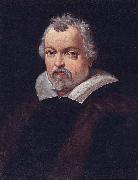 |
Emilian School 
|
|
painted Ludovico Carracci in 17th century
|
|
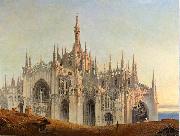 |
Emilio Magistretti 
|
|
(Milan, 1851 - 1936) was an Italian painter.
Magistretti studied at the Brera Academy of Fine Arts from 1871 to 1875 under the guidance of Francesco Hayez and then accompanied him on his Italian journey of 1879. He worked initially in a range of different areas, from genre scenes to religious subjects and perspective painting, and successfully tried his hand at painting portraits, animals and landscapes at the turn of the century. He began to establish his reputation as an artist in 1880, when he was awarded a prize by the Ministry of Education, and became well known as a painter of moderately naturalistic portraits particularly appreciated by the middle-class establishment. An autobiography richly illustrated with reproductions of his most celebrated works was published in 1926.
|
|
 |
Emily Carr 
|
|
Canadian Expressionist Painter, 1871-1945
Canadian painter and writer. She studied art from 1891 to 1894 at the California School of Design in San Francisco. She lived in England from 1899 to 1904, studying at the Westminster School of Art in 1899, and settled in Vancouver on her return. Her stay in Paris in 1910-11, during which she had a painting shown at the Salon d'Automne in 1911, proved far more influential on her art, familiarizing her with Impressionism, with Post-Impressionism and with Fauvism.
|
|
 |
Emma Brownlow King 
|
|
British, 1832-1905
|
|
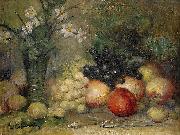 |
Emma Ekwall 
|
|
painted Stilleben med frukter in 1838-1925
|
|
|
|
|
|
|
|
|
| Wholesale China Oil Painting Wholesale Oil Painting China Xiamen Portrait Reproduction on canvas Chinese Oil Painting Wholesale USA Oil Painting |
|
|
|
|